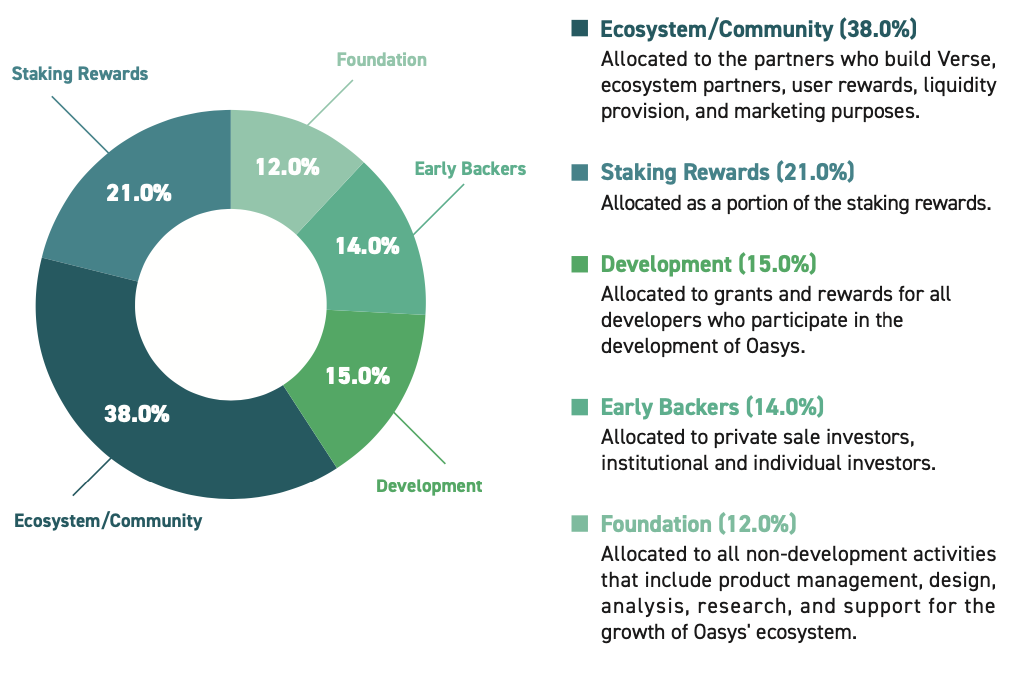Tokenomics
Overview
A sustainable, public, decentralized network can be maintained by incentivizing network participants with tokens. It is also important for Oasys to create a token-based ecosystem, Tokenomics.
Tokenomics throughout Oasys is based on a multi-token economy, not a single token economy using only OAS tokens, Oasys' native token. Oasys includes OAS Token, the primary token for Oasys, Verse Token, the primary token for Verse, and Game Token and Dapps Token, the primary tokens for games and Dapps.
The reason for adopting a multi-token economy instead of a single-token economy is to allow Verse Builders and Game Developers the opportunity to create their ecosystems freely. As Oasys expands its ecosystem as a gaming chain, it is necessary to prepare for various types of Verses and multiple genres of games to be deployed in the ecosystem. Some Verses are permissionless and are intended for games and Dapps of many different genres to be deployed. In contrast, others may only allow limited IP content to be deployed to create a unique worldview. Games on each Verse include many genres, from light casual games to heavy FPS and MMORPGs. The differences in the type of content and businesses of these Verses and games require flexibility for developers in the token design.
In a single-token economy, the total number of tokens issued and their allocation is initially determined, making it difficult for Verse and games to allocate tokens as they come onto the Oasys ecosystem one after the other. Also, tokens on Verse, games, and Dapps are linked to the entire Oasys ecosystem, making the utility more complex.
Oasys is building an ecosystem based on a multi-token economy: OAS tokens, the native tokens that are the infrastructure of the Oasys ecosystem; Verse Tokens, which are used to create an ecosystem for each Verse; and Game Tokens and Dapps Tokens, which are used for games and Dapps within the Verse. Tokenomics is structured in this way with multiple layers. Each Verse Builder can build its own ecosystem of token utilities, the total number of tokens issued, allocations, etc., according to the characteristics of its Verse. For example, a permissionless Verse can set gas fees as the Verse Token utility, while a Verse, which limits deployments to only its own IP content to preserve its worldview, can provide tokens to existing fans. Games and Dapps can also issue tokens, and the tokenomics can be designed optimally for each game or Dapp. For example, an MMORPG can grant tokens based on a user's contribution to the community, whereas a casual game can grant tokens for completing the game, and so on.
Token Utilities
Oasys' native token is the OAS token which is the highest level token in the entire Oasys ecosystem and is issued on the Oasys public chain to maximize Oasys Tokenomics. And the total supply at launch is 10 billion tokens. Six years after the mainnet launch, OAS token holders will determine the additional supply of staking rewards through decentralized governance.
OAS tokens have the following uses.
1. Gas Fees
Due to the architecture of Oasys, the performer of the contract pays gas fees when rolling up transactions from a Verse Layer to the Hub Layer, when using a Bridge contract, or when running a contract on the Hub Layer. Gas fees for rolling up are paid by Verse Builder, and as the Oasys ecosystem grows, the more Verse Layers and the more Transactions per Verse, the higher the gas fees. However, Oasys is designed so that the increase in gas fees will be gradual. By accelerating the growth of Verse Builder's business through the growth of the entire ecosystem, the disadvantage of rising gas fees is minimal.
2. Verse Building Deposits
Anyone can build a Verse if they deposit more than 1 million OAS toward the verse contract. By imposing a certain amount of initial Verse Building Deposits, the ecosystem can be soundly expanded to prevent the sprawl of scammy Verses and to ensure a long-term commitment by Verse Builders.
3. Decentralized Governance
OAS token holders can participate in Oasys' decision-making through decentralized governance. Proposals include changes in inflation rates through staking, treasury uses, Vote to decide which contract to build on Hub-Layer, etc.
4. Staking Rewards
Staking OAS tokens allows you to receive staking rewards. Anyone staking 10 million OAS or more through a validator contract can become a validator.
5. Payment
In many games, a large number of micropayments are made daily through primary distribution of digital content. In the Oasys ecosystem, OAS tokens can be used for many micropayments in and out of the games. OAS tokens will serve as the key currency in the entire Oasys ecosystem. This is similar to the way ETH tokens stand in the Ethereum ecosystem.
Initial Token Allocation
The total initial supply is 10 billion OAS tokens which will be distributed according to the following allocations.

Token Supply Curve
Circulating supply must be a well-balanced design that considers the long-term growth and sustainability of Oasys.
